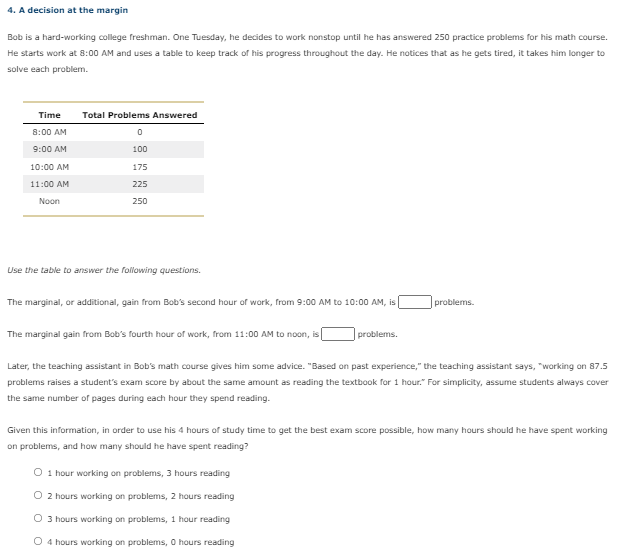4. A decision at the margin Bob is a hard-working college freshman. One Tuesday, he decides to work nonstop until he has answered 250 practice problems for his math course. He starts work at 8:00 AM and uses a table to keep track of his progress throughout the day. He notices that as he gets tired, it takes him longer to solve each problem. Time Total Problems Answered 8:00 AM 9:00 AM 100 10:00 AM 175 11:00 AM 225 Noon 250 Use the table to answer the following questions. The marginal, or additional, gain from Bob's second hour of work, from S9:00 AM to 10:00 AM, is problems. The marginal gain from Bob's fourth hour of work, from 11:00 AM to noon, is problems. Later, the teaching assistant in Bob's math course gives him some advice. "Based on past experience," the teaching assistant says, "working on 87.5 problems raises a student's exam score by about the same amount as reading the textbook for 1 hour." For simplicity, assume students always cover the same number of pages during each hour they spend reading. Given this information, in order to use his 4 hours of study time to get the best exam score possible, how many hours should he have spent working on problems, and how many should he have spent reading? O 1 hour working on problems, 3 hours reading O 2 hours working on problems, 2 hours reading O 3 hours working on problems, 1 hour reading O 4 hours working on problems, O hours reading
4. A decision at the margin Bob is a hard-working college freshman. One Tuesday, he decides to work nonstop until he has answered 250 practice problems for his math course. He starts work at 8:00 AM and uses a table to keep track of his progress throughout the day. He notices that as he gets tired, it takes him longer to solve each problem. Time Total Problems Answered 8:00 AM 9:00 AM 100 10:00 AM 175 11:00 AM 225 Noon 250 Use the table to answer the following questions. The marginal, or additional, gain from Bob's second hour of work, from S9:00 AM to 10:00 AM, is problems. The marginal gain from Bob's fourth hour of work, from 11:00 AM to noon, is problems. Later, the teaching assistant in Bob's math course gives him some advice. "Based on past experience," the teaching assistant says, "working on 87.5 problems raises a student's exam score by about the same amount as reading the textbook for 1 hour." For simplicity, assume students always cover the same number of pages during each hour they spend reading. Given this information, in order to use his 4 hours of study time to get the best exam score possible, how many hours should he have spent working on problems, and how many should he have spent reading? O 1 hour working on problems, 3 hours reading O 2 hours working on problems, 2 hours reading O 3 hours working on problems, 1 hour reading O 4 hours working on problems, O hours reading
Principles of Economics 2e
2nd Edition
ISBN:9781947172364
Author:Steven A. Greenlaw; David Shapiro
Publisher:Steven A. Greenlaw; David Shapiro
Chapter22: Inflation
Section: Chapter Questions
Problem 4SCQ: Edna is living in a retirement home where home where most of her needs are taken care of, but she...
Related questions
Question
This is for

Transcribed Image Text:4. A decision at the margin
Bob is a hard-working college freshman. One Tuesday, he decides to work nonstop until he has answered 250 practice problems for his math course.
He starts work at 8:00 AM and uses a table to keep track of his progress throughout the day. He notices that as he gets tired, it takes him longer to
solve each problem.
Time
Total Problems Answered
8:00 AM
9:00 AM
100
10:00 AM
175
11:00 AM
225
Noon
250
Use the table to answer the following questions.
The marginal, or additional, gain from Bob's second hour of work, from S9:00 AM to 10:00 AM, is
problems.
The marginal gain from Bob's fourth hour of work, from 11:00 AM to noon, is
problems.
Later, the teaching assistant in Bob's math course gives him some advice. "Based on past experience," the teaching assistant says, "working on 87.5
problems raises a student's exam score by about the same amount as reading the textbook for 1 hour." For simplicity, assume students always cover
the same number of pages during each hour they spend reading.
Given this information, in order to use his 4 hours of study time to get the best exam score possible, how many hours should he have spent working
on problems, and how many should he have spent reading?
O 1 hour working on problems, 3 hours reading
O 2 hours working on problems, 2 hours reading
O 3 hours working on problems, 1 hour reading
O 4 hours working on problems, O hours reading
Expert Solution
This question has been solved!
Explore an expertly crafted, step-by-step solution for a thorough understanding of key concepts.
Step by step
Solved in 2 steps

Knowledge Booster
Learn more about
Need a deep-dive on the concept behind this application? Look no further. Learn more about this topic, economics and related others by exploring similar questions and additional content below.Recommended textbooks for you

Principles of Economics 2e
Economics
ISBN:
9781947172364
Author:
Steven A. Greenlaw; David Shapiro
Publisher:
OpenStax

Principles of Economics 2e
Economics
ISBN:
9781947172364
Author:
Steven A. Greenlaw; David Shapiro
Publisher:
OpenStax